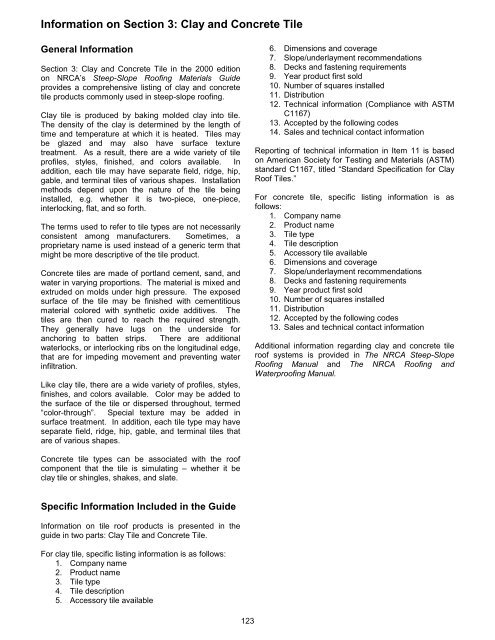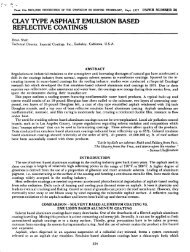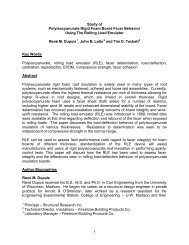2000 by the National Roofing Contractors Association. No
2000 by the National Roofing Contractors Association. No
2000 by the National Roofing Contractors Association. No
You also want an ePaper? Increase the reach of your titles
YUMPU automatically turns print PDFs into web optimized ePapers that Google loves.
Information on Section 3: Clay and Concrete Tile<br />
General Information<br />
Section 3: Clay and Concrete Tile in <strong>the</strong> <strong>2000</strong> edition<br />
on NRCA’s Steep-Slope <strong>Roofing</strong> Materials Guide<br />
provides a comprehensive listing of clay and concrete<br />
tile products commonly used in steep-slope roofing.<br />
Clay tile is produced <strong>by</strong> baking molded clay into tile.<br />
The density of <strong>the</strong> clay is determined <strong>by</strong> <strong>the</strong> length of<br />
time and temperature at which it is heated. Tiles may<br />
be glazed and may also have surface texture<br />
treatment. As a result, <strong>the</strong>re are a wide variety of tile<br />
profiles, styles, finished, and colors available. In<br />
addition, each tile may have separate field, ridge, hip,<br />
gable, and terminal tiles of various shapes. Installation<br />
methods depend upon <strong>the</strong> nature of <strong>the</strong> tile being<br />
installed, e.g. whe<strong>the</strong>r it is two-piece, one-piece,<br />
interlocking, flat, and so forth.<br />
The terms used to refer to tile types are not necessarily<br />
consistent among manufacturers. Sometimes, a<br />
proprietary name is used instead of a generic term that<br />
might be more descriptive of <strong>the</strong> tile product.<br />
Concrete tiles are made of portland cement, sand, and<br />
water in varying proportions. The material is mixed and<br />
extruded on molds under high pressure. The exposed<br />
surface of <strong>the</strong> tile may be finished with cementitious<br />
material colored with syn<strong>the</strong>tic oxide additives. The<br />
tiles are <strong>the</strong>n cured to reach <strong>the</strong> required strength.<br />
They generally have lugs on <strong>the</strong> underside for<br />
anchoring to batten strips. There are additional<br />
waterlocks, or interlocking ribs on <strong>the</strong> longitudinal edge,<br />
that are for impeding movement and preventing water<br />
infiltration.<br />
Like clay tile, <strong>the</strong>re are a wide variety of profiles, styles,<br />
finishes, and colors available. Color may be added to<br />
<strong>the</strong> surface of <strong>the</strong> tile or dispersed throughout, termed<br />
“color-through”. Special texture may be added in<br />
surface treatment. In addition, each tile type may have<br />
separate field, ridge, hip, gable, and terminal tiles that<br />
are of various shapes.<br />
Concrete tile types can be associated with <strong>the</strong> roof<br />
component that <strong>the</strong> tile is simulating – whe<strong>the</strong>r it be<br />
clay tile or shingles, shakes, and slate.<br />
Specific Information Included in <strong>the</strong> Guide<br />
Information on tile roof products is presented in <strong>the</strong><br />
guide in two parts: Clay Tile and Concrete Tile.<br />
For clay tile, specific listing information is as follows:<br />
1. Company name<br />
2. Product name<br />
3. Tile type<br />
4. Tile description<br />
5. Accessory tile available<br />
123<br />
6. Dimensions and coverage<br />
7. Slope/underlayment recommendations<br />
8. Decks and fastening requirements<br />
9. Year product first sold<br />
10. Number of squares installed<br />
11. Distribution<br />
12. Technical information (Compliance with ASTM<br />
C1167)<br />
13. Accepted <strong>by</strong> <strong>the</strong> following codes<br />
14. Sales and technical contact information<br />
Reporting of technical information in Item 11 is based<br />
on American Society for Testing and Materials (ASTM)<br />
standard C1167, titled “Standard Specification for Clay<br />
Roof Tiles.”<br />
For concrete tile, specific listing information is as<br />
follows:<br />
1. Company name<br />
2. Product name<br />
3. Tile type<br />
4. Tile description<br />
5. Accessory tile available<br />
6. Dimensions and coverage<br />
7. Slope/underlayment recommendations<br />
8. Decks and fastening requirements<br />
9. Year product first sold<br />
10. Number of squares installed<br />
11. Distribution<br />
12. Accepted <strong>by</strong> <strong>the</strong> following codes<br />
13. Sales and technical contact information<br />
Additional information regarding clay and concrete tile<br />
roof systems is provided in The NRCA Steep-Slope<br />
<strong>Roofing</strong> Manual and The NRCA <strong>Roofing</strong> and<br />
Waterproofing Manual.





